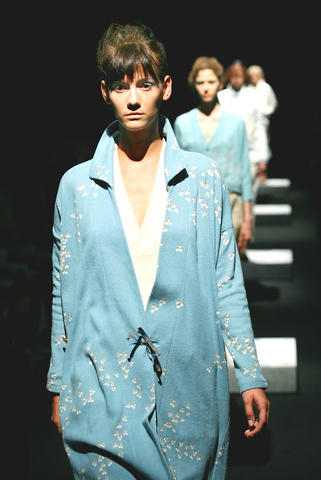Gut's Dynamite Cabarets was one of the hot stocks of the 2008 spring-summer Tokyo Collection.
But unlike the tall, skinny and streamlined shapes typically seen on the catwalk, the clothes of Gut's Dynamite Cabarets were displayed by sexy and often lofty men, some posing as drag queens.
"All the clothes at my house are for occasions like crucial dates, the moment at which you have to be very sexy," said creative director Cabaret Aki.

"When you think of the underwear we design, you can tell. They are for those important moments," said Aki, who started the fashion house as a male underwear brand.
Japan has been trying to catch up with the world's other major fashion hubs like Paris, New York and Milan, throwing the Japan Fashion Week in Tokyo since 2005, with a major boost from the Industry Ministry.
The Tokyo Collection is the core of the week-long event, a head start for the world's 2008 spring-summer collections, with designers from veterans to new aces giving off the scent of exoticism in their shows at the event, which finished yesterday.

PHOTO: AFP
Among the few ladies' items at Gut's Dynamite Cabarets were its camisole dresses, which were feminine but assertive with thin shoulder straps and layers of frills down to just below the torso.
Gut's Dynamite Cabarets is all about flamboyance, decorated with countless red and black roses, cluttering gold chains and any kinky material you can think of like leather, feathers and fur.
The bling-bling strangely matched the catwalk tune of Frank Sinatra's My Way, as if everyone on stage was celebrating life itself.
Despite the cross-dressing show, Aki said he and his co-designer Jackal Kuzu created clothes that were ready to wear on the street.
"Many styles you see in the Tokyo Collection are luxurious but casual, and are very sophisticated," he said after the show. "We tried to keep a kinky touch to our clothes, which are still wearable in real life."
"Also, since this is the spring-summer collection, we added some scary feelings, like a ghost," he added.
Fashion house Matohu stood out among the 38 brands participating here for its Japanese touch.
While the Japanese look is often considered kawaii (cute), designer duo Hiroyuki Horihata and Makiko Sekiguchi took the theme of the Keicho era (1596-1615), a mere two decades in Japanese history that featured some outstanding style.
The style - humble like Japanese rituals but brilliant like the hue of green tea - swept the country's trend-conscious echelons of power at the time.
"We want to offer clothes that have something more than just looking cute or pretty in silhouette," Horihata said. "We want to add something more than simply the fashion."
In the latest collection, "something more" for Matohu is the foamy but rugged Shino style of earthenware that was in vogue back then.
"To give the touch of cracking which you see on the surface of the pottery, we printed the design on silk," said Sekiguchi.
"It's such a gentle and airy touch with some distorted feeling," Horihata said. "Knowing what Shino is or not makes such a difference to those who put on our clothes."
Horihata said he and Sekiguchi spend twice as much time to prepare for a single collection, seeking the best material to satisfy both the creators' artistic drive and consumers' practicality.
"Unless you can actually wear them, it would be useless," Horihata said.
"We also think about what our clothes will be like after being washed at home."
Norio Surikabe, the designer of Support Surface, whose pristine style and natural material of cotton and linen create an extremely streamlined silhouette, was more definitive.
"I think about how the people wearing them feel, so we use dry-touch linen for this season of high humidity," he said. "I do not compromise. People may say my style is plain, but for me, those who wear my clothes are the priority."

“Why does Taiwan identity decline?”a group of researchers lead by University of Nevada political scientist Austin Wang (王宏恩) asked in a recent paper. After all, it is not difficult to explain the rise in Taiwanese identity after the early 1990s. But no model predicted its decline during the 2016-2018 period, they say. After testing various alternative explanations, Wang et al argue that the fall-off in Taiwanese identity during that period is related to voter hedging based on the performance of the Democratic Progressive Party (DPP). Since the DPP is perceived as the guardian of Taiwan identity, when it performs well,

The Taiwan People’s Party (TPP) on May 18 held a rally in Taichung to mark the anniversary of President William Lai’s (賴清德) inauguration on May 20. The title of the rally could be loosely translated to “May 18 recall fraudulent goods” (518退貨ㄌㄨㄚˋ!). Unlike in English, where the terms are the same, “recall” (退貨) in this context refers to product recalls due to damaged, defective or fraudulent merchandise, not the political recalls (罷免) currently dominating the headlines. I attended the rally to determine if the impression was correct that the TPP under party Chairman Huang Kuo-Chang (黃國昌) had little of a

At Computex 2025, Nvidia CEO Jensen Huang (黃仁勳) urged the government to subsidize AI. “All schools in Taiwan must integrate AI into their curricula,” he declared. A few months earlier, he said, “If I were a student today, I’d immediately start using tools like ChatGPT, Gemini Pro and Grok to learn, write and accelerate my thinking.” Huang sees the AI-bullet train leaving the station. And as one of its drivers, he’s worried about youth not getting on board — bad for their careers, and bad for his workforce. As a semiconductor supply-chain powerhouse and AI hub wannabe, Taiwan is seeing

Jade Mountain (玉山) — Taiwan’s highest peak — is the ultimate goal for those attempting a through-hike of the Mountains to Sea National Greenway (山海圳國家綠道), and that’s precisely where we’re headed in this final installment of a quartet of articles covering the Greenway. Picking up the trail at the Tsou tribal villages of Dabang and Tefuye, it’s worth stocking up on provisions before setting off, since — aside from the scant offerings available on the mountain’s Dongpu Lodge (東埔山莊) and Paiyun Lodge’s (排雲山莊) meal service — there’s nowhere to get food from here on out. TEFUYE HISTORIC TRAIL The journey recommences with